Purcell & Elmslie
The American progressive architectural practice most widely known as Purcell & Elmslie (P&E) was the second most commissioned firm of the Prairie School after Frank Lloyd Wright. The firm had offices in Chicago, Philadelphia, and Minneapolis.[1]
The firms consisted of three partnerships: Purcell and Feick (1907–10); Purcell, Feick, and Elmslie (1910–12), and Purcell and Elmslie (1913–21). The architects were commissioned for work in twenty-two states, participated in the competition for the National Parliament Buildings in Canberra, Australia, and prepared plans for a large institutional church, or Y.M.C.A., in Hunan, China.
Two principals of the firm, William Gray Purcell (1880–1965) and George Grant Elmslie (1869–1952) both eventually received Fellowships in the College of the American Institute of Architects.[1]
The original partner with Purcell was George Feick, Jr. who was son of George Feick, an Ohio contractor. Purcell and Feick had been students together at Cornell University. They rejoined to tour in Europe together during 1906-1907 and then came to Minneapolis to open their partnership.
A number of works by each of the partnerships are listed on the National Register of Historic Places.[2]
Notable commissions
- Steven House (1909), Eau Claire, Wisconsin
- Dr. Ward Beebe House (1912), Saint Paul, Minnesota
- Josephine Crane Bradley summer residence (Bradley Bungalow) (1912) Woods Hole, Massachusetts
- Edison Shop (1912) Chicago, Illinois
- Merchants National Bank (1912), Winona, Minnesota
- Edna S. Purcell House (1913), Minneapolis, Minnesota
- Woodbury County Courthouse (1918), Sioux City, Iowa William L. Steele, Architect, Purcell & Elmslie, Associated Architects (George Grant Elmslie, designing architect)
Works include (with attribution):[2]
- works by Purcell & Feick
- Feick Building, built 1909, at 158-160 E. Market St. Sandusky, OH (Purcell & Feick), NRHP-listed[2]
- Steven House, built 1909, at 606 Second Ave. Eau Claire, WI (Purcell & Feick), NRHP-listed[2]
- Stewart Memorial Presbyterian Church, built 1910, at 116 E. 32nd St. Minneapolis, MN (Purcell & Feick), NRHP-listed[2]
- works by Purcell, Feick & Elmslie
- A. B. C. Dodd House, built 1910, at 310 3rd Ave. Charles City, IA (Purcell,Feick & Elmslie), NRHP-listed[2]
- Two or three works in the NRHP-listed Bismarck Cathedral Area Historic District, roughly bounded by Hannifan and N 1st Sts., Aves. C and A West Bismarck, ND (Purcell,Feick & Elmslie), NRHP-listed,[2] specifically the Prairie School residences at 120 Avenue A West, at 610 Raymond Street, and at 402 Avenue B West. The Patrick E. Byrne House (120 Avenue A West) was built in 1912; the Timothy R. Atkinson House (402 Avenue B West) was built c.1910.[3]:2,12, 14, 18
- Merchants National Bank, built in 1912, at 102 E. 3rd St. Winona, MN (Purcell,Feick & Elmslie), NRHP-listed[2]
- Dr. Oscar Owre House, built 1912, at 2625 Newton Ave., S., Minneapolis, MN (Purcell,Feick & Elmslie), NRHP-listed[2]
- Merton S. Goodnow House, built 1913, at 446 S. Main St. Hutchinson, MN (Purcell,Feick & Elmslie), NRHP-listed[2]
- Charles and Grace Parker House, built 1913, at 4829 Colfax Ave. S. Minneapolis, MN (Purcell,Feick & Elmslie), NRHP-listed[2]
- Dr. John H. Adair House, built 1913, at 322 E. Vine St. Owatonna, MN (Purcell,Feick & Elmslie), NRHP-listed[2]
- works by Purcell & Elmslie
- One or more works in College Hills Historic District, roughly bounded by Colombia Rd., Amherst Dr., Bowdoin Rd., Corporate Limit, University Bay, and Harvard Dr. Shorewood Hills, WI (Purcell and Elmslie), NRHP-listed[2]
- Community House, First Congregational Church, 310 Broadway Eau Claire, WI (Purcell & Elmslie), NRHP-listed[2]
- Exchange State Bank, NW corner of Main and 1st Sts. Grand Meadow, MN (Purcell & Elmslie), NRHP-listed[2]
- First National Bank (Rhinelander, Wisconsin), 8 W. Davenport St. Rhinelander, WI (Purcell & Elmslie), NRHP-listed[2]
- First National Bank of Adams, 322 Main St. Adams, MN (Purcell & Elmslie), NRHP-listed[2]
- First State Bank of LeRoy, Main St. and Broadway LeRoy, MN (Purcell & Elmslie), NRHP-listed[2]
- Dr. J. W. S. Gallagher House, 451 W. Broadway St. Winona, MN (Purcell & Elmslie), NRHP-listed[2]
- Jump River Town Hall, S of WI 73 Jump River, WI (Purcell & Elmslie), NRHP-listed[2]
- Kasson Municipal Building, 12 W. Main Kasson, MN (Purcell & Elmslie), NRHP-listed[2]
- Mrs. Richard Polson House, N of Spooner Spooner, WI (Purcell & Elmslie), NRHP-listed[2]
- William Gray Purcell House, 2328 Lake Pl. Minneapolis, MN (Purcell & Elmslie), NRHP-listed[2]
- Windego Park Auditorium/Open Air Theater, between S. Ferry St. and Rum River Anoka, MN (Purcell & Elmslie), NRHP-listed[2]
- Woodbury County Courthouse, 7th and Douglas Sts. Sioux City, IA (Purcell & Elmslie), NRHP-listed[2]
Photo Gallery
-

Stewart Memorial Presbyterian Church; Minneapolis, Minnesota 1910, Purcell & Feick
-
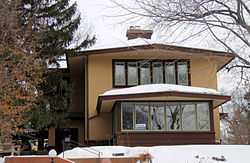
Oscar Owre House; Minneapolis, Minnesota 1911
-
Merchants National Bank (Winona, Minnesota), 1912 by Purcell and Elmslie
-
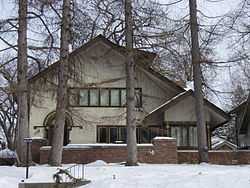
Parker House; Minneapolis, Minnesota 1912-13
-

Edna S. Purcell House; Minneapolis, Minnesota 1913 by Purcell and Elmslie
-
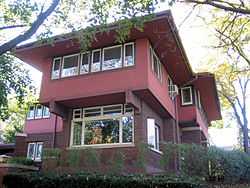
E.S. Hoyt House; Red Wing, Minnesota 1913
-
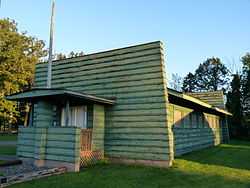
McKinley Town Hall; Jump River, Wisconsin 1915
-
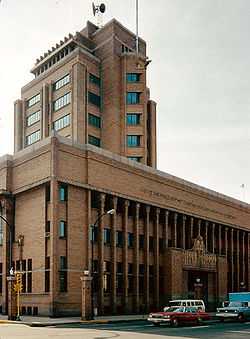
Woodbury County Courthouse; Souix City, Iowa 1916-18; with associated architect William L. Steele
References
- ↑ 1.0 1.1 Architecture In the Spirit of Democracy
- ↑ 2.0 2.1 2.2 2.3 2.4 2.5 2.6 2.7 2.8 2.9 2.10 2.11 2.12 2.13 2.14 2.15 2.16 2.17 2.18 2.19 2.20 2.21 2.22 2.23 2.24 "National Register Information System". National Register of Historic Places. National Park Service. 2010-07-09.
- ↑ Frank E. Vyzralek and Louis N. Hafermehl (February 28, 1980). "National Register of Historic Places Registration: The Hill / Bismarck Cathedral Area Historic District". National Park Service. and accompanying photos
Further reading
- Brooks, H. Allen, The Prairie School, W.W. Norton, New York 2006; ISBN 0-393-73191-X
- Brooks, H. Allen (editor), Prairie School Architecture: Studies from "The Western Architect", University of Toronto Press, Toronto, Buffalo 1975; ISBN 0-8020-2138-7
- Brooks, H. Allen, The Prairie School: Frank Lloyd Wright and his Midwest Contemporaries, University of Toronto Press, Toronto 1972; ISBN 0-8020-5251-7
- Gebhard, David (edited by Patricia Gebhard), Purcell & Elmslie: Prairie Progressive Architects, Gibbs Smith, Salt Lake City 2006, ISBN 1-4236-0005-3
- Hammons, Mark, "Purcell and Elmslie, Architects," in Art and Life on the Upper Mississippi: Minnesota 1900, University of Delaware Press, 1994 ISBN 0-87413-560-5.
External links
| Wikimedia Commons has media related to Purcell & Elmslie. |
- Purcell and Elmslie at Organica
